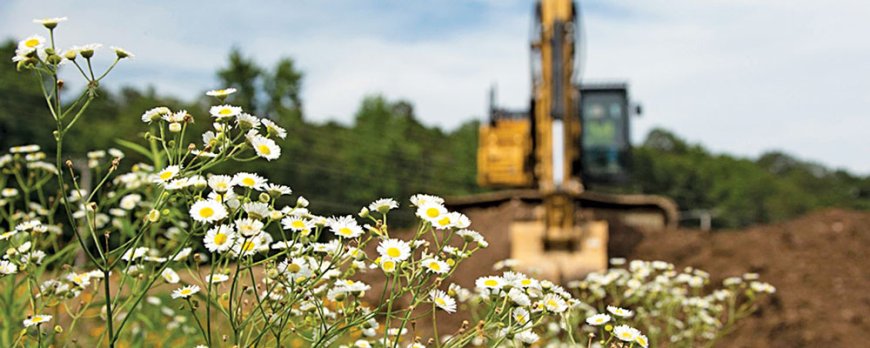Sustainability – A Core Focus Area of Caterpillar’s Enterprise Strategy
The recent publication of Caterpillar’s Sustainability Report illustrates the strong work of its diverse global team.

The recent publication of Caterpillar’s Sustainability Report illustrates the strong work of its diverse global team. The Sustainability Report highlights Caterpillar’s Environmental, Social and Governance (ESG) progress. Highlights from the report…
Caterpillar is a global company committed to living Our Values in Action, executing our enterprise strategy and serving our customers to build a better, more sustainable world.
The combination of the energy transition and our work to help our customers achieve their climate-related objectives led us to add sustainability as a focus area of Caterpillar’s enterprise strategy. Caterpillar’s Values in Action are the foundation for our work, guiding us on our sustainability journey.
2030 Sustainability Goals and Progress
We have established seven sustainability goals to achieve by 2030, including five climate- and environmental-related goals and two focused on employee and customer safety .
In 2021, we further emphasized our commitment to reducing product-related emissions by disclosing an additional new goal that 100% of our new products through 2030 will be more sustainable than the previous generation.
Progress
- More than 50 new products in 2022 satisfied the goal criteria for reduced waste, improved design for rebuild/remanufacturing, improved efficiency and/or lower emissions.
- 100% new products introduced in 2022 were more sustainable than previous generations.
- Reduced emissions with four battery electric machine prototypes: the Cat®301.9 mini excavator, 320 medium excavator, 950 GC medium wheel loader and 906 compact wheel loader
- Improved fuel efficiency through products such as Progress Rail’s first hybrid intermediate power EMD® GT38H locomotives, to be delivered in 2023
Caterpillar utilizes guidance from the GHG Protocol to calculate Scope 3 GHG emissions. Our Scope 3 emissions are estimated to be more than 95% of the company’s total Scope 1, 2 and 3 GHG emissions inventory. Given the company’s large, global customer base covering a diverse set of industries, including construction and mining equipment, off-highway diesel and natural gas engines, industrial gas turbines, diesel-electric locomotives, and others, Category 11 — use of sold products — is our largest Scope 3 category.
Building a better, more sustainable world
Over the past 20 years, we have invested more than $30 billion in R&D to deliver best-in-class innovation, including autonomy, alternative fuels, connectivity and digital, and electrification (AACE) technologies. We integrate the energy technologies developed by our Energy & Transportation (E&T) segment into machines manufactured by our Resource Industries (RI) and Construction Industries (CI) segments, providing an advantage to our customers as we help them achieve their objectivesOur enterprise energy management team builds awareness, encourages action and develops improvements in energy efficiency and renewable power generation. These solutions include installing renewable energy technologies, such as photovoltaics (PV) or microgrid installations that combine PV with battery storage to supplement and offset electricity generated with diesel fuel at off-grid locations. One significant contribution to alternative energy consumption is the operation of combined heat and power (CHP) systems to power several manufacturing facilities.
Cat Reman gives materials a new life, delivers sustainability benefits to our customers and helps Caterpillar contribute to the circular economy. Caterpillar has been remanufacturing for 50 years of our nearly 100 years in business. Today, remanufacturing is at the heart of our strategy to help customers build a better, more sustainable world. When a component reaches the end of its initial serviceable life, a dealer can return the used component, or core, to Caterpillar. That core is cleaned, inspected, salvaged and remanufactured to original factory quality and performance specifications.
Autonomous Technology: Caterpillar leads the industry in autonomy. We have the largest autonomous truck fleet in the world, with over 580 machines and more launching every year.
Alternative Fuels: Fuel choice is one way that customers can reduce lifecycle GHG emissions today. Many Caterpillar products operate on lower-carbon intensity fuels, including biodiesel, renewable diesel and biogas. These fuels reduce lifecycle GHG emissions in the fuel value chain; GHG emissions at the tailpipe are essentially the same as traditional fuels. For example, all Caterpillar diesel engines can operate on 100% HVO (Hydrotreated Vegetable Oil).
Connectivity: For more than 20 years, Caterpillar has been connecting machines and using telematics to create machine insights. The data from 1.4 million connected assets helps customers operate their fleets more efficiently to optimize productivity and conserve resources such as fuel. We added to our software portfolio in 2022 with the acquisition of Tangent Energy Solutions, which provides customers turnkey solutions for reducing energy costs, monetizing electric grid support, and providing resiliency for customer operations.
Electrification: Caterpillar is committed to delivering robust electrified products and solutions for our customers. We are gaining valuable experience from our initial introductions of battery-powered equipment and the additional battery-powered machines and chargers under development will help our customers achieve their climate-related objectives. Electric drivetrains and hybrid powertrains employ an electric drive transmission with power components to improve energy efficiency and productivity.
Our products are built to be rebuilt. They are designed to withstand heavy-duty operating conditions and to be restored and used for multiple lifecycles, reducing the need for raw materials and associated GHG emissions. Designing products and components to be used throughout multiple service lifecycles is the essence of our remanufacturing approach across multiple products and brands.
Cat Reman gives materials a new life, delivers sustainability benefits to our customers and helps Caterpillar contribute to the circular economy. Caterpillar has been remanufacturing for 50 years of our nearly 100 years in business. Today, remanufacturing is at the heart of our strategy to help customers build a better, more sustainable world. When a component reaches the end of its initial serviceable life, a dealer can return the used component, or core, to Caterpillar. That core is cleaned, inspected, salvaged and remanufactured to original factory quality and performance specifications. This includes any relevant engineering updates.
Hits: 10








